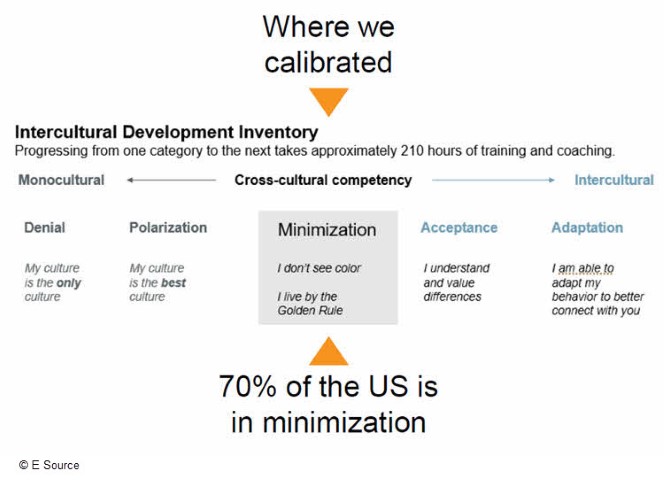
Many of us were taught the Golden Rule as a standard of behavior—do unto others as we’d like done unto us. But to achieve equity, we need to adopt the Platinum Rule—do unto others as they would like done unto them.
Practicing the Platinum Rule takes intercultural competency, which is the ability to understand what you have in common with another person or group as well as appreciate that what makes everyone different makes a difference. Intercultural competency can be measured, built, and deployed to make better decisions and achieve better results.
Similarities and differences matter in equity
Achieving equity (especially in the transition to a clean energy future) is probably the toughest challenge utilities have ever faced. It’s hard because most of us think we’ve got equity figured out simply because we subscribe to the Golden Rule. But there are two primary levers to solving for equity: One is based on bonding over similarities. The other is understanding the differences that make a difference.
Bonding over similarities is the essence of the Golden Rule. Decision-makers tend to apply their point of view as the perspective for planning the solution. The problem in doing that is that in solving for your own worldview, you discount the lived experiences of diverse stakeholders. You solve for making things better for everyone without addressing the underlying issues that keep diverse stakeholders from fully benefiting from a clean energy future. For example, while building a better energy efficiency program may increase overall participation, it may not go far enough to address specific systematic issues, like The Lasting Legacy Of Redlining that stand in the way of equity.
Disenfranchised communities. Parts of the communities that pay into the rate base that funds the energy efficiency programs would never be able to participate in them due to:
- Lack of resources to make the initial investment in energy efficiency, EVs, solar, etc.
- Lack of weatherization in dwellings, which often needs to happen before making energy efficiency upgrades or putting up solar panels
- Lack of homeownership, which prevents investment in energy efficiency, EV chargers, solar, etc.
Legacy effects of structural racism based in real estate. As discussed in the MasterClass Black History, Freedom & Love: Lessons from Influential Black Voices, problems such as discrimination in financing, neighborhoods that can be bought into, and others that have been disinvested in are adding up to less net worth and greater energy burden. They’re also leading to poorer health outcomes because severe weather in disinvested neighborhoods makes them more susceptible to global warming and urban flooding. And a lack of home weatherization leads to mold and other contributors to chronic health conditions.
The Golden Rule = minimization
The Golden Rule calibrates as minimization—squeezing all other cultures and worldviews into your own values and lens. Minimization is a category measured in the Intercultural Development Inventory (IDI) as monocultural. It focuses on universal similarities but glosses over differences. In essence, those in minimization think everyone is more alike than different and that the path to equity is focusing on those similarities. That’s primarily based on the belief that the Golden Rule is universal and that everyone tends to live by it, leading to the immediate discounting of other worldviews. Core E Source team members have taken the IDI and calibrated in the minimization category (figure 1).
Figure 1: E Source IDI results
According to Psychology Today’s Bias page, humans are biased by nature. This is often acquired at a young age and something we’re not aware of. Split-second decision-making and fight-or-flight responses kept us alive as a species, but they also left us vulnerable to a host of cognitive and cultural biases that get in the way of equitable decision-making.
Most of us aren’t even aware of our biases and how they get in the way of our decision-making, program design, and outreach efforts. Equity requires us to change our thinking—especially at the top of our organizations. More than 70% of change fails because of a lack of active, visible sponsorship, as discussed in The Sponsor as the Face of Organizational Change by the Project Management Institute. Equity is seen as a “nice to do.” It’s “something that’s already in our DNA” and something we already have competency in. But that’s incorrect. According to Utilizing the Intercultural Development Inventory to develop intercultural competence by the National Library of Medicine, 70% of corporate America calibrates at Minimization, which means we’re implementing equity based on what we’d like to see. And it’s not working.
Any historic gap that you want to measure—energy equity, food insecurity, housing, education, small business survival—is bigger than ever. The pandemic exposed the inequities and made them more visible. It’s time we turned our attention inward.
Equitable change happens from the inside out
Equitable decisions are made by interculturally competent individuals and organizations. Intercultural competency doesn’t just happen on its own; it’s the product of education, training, self-reflection, and application. And it should be measured and tracked. Below are some ideas for building your intercultural competency, and E Source can help.
- Take the IDI assessment. If you’re a leader, this is especially important. Leadership in equity comes from the top, and it’s important that decisions are calibrated to a benchmark of intercultural competency.
- Review the debrief of your IDI report and development plan. Contextualize where you are on the IDI continuum and what you want to achieve personally and professionally.
- Join a cohort that’s focused on the same objectives. E Source is launching an equity cohort to provide consulting, training, peer feedback, and validation of your strategy, plan, and implementation. It’s designed to be the accountability partner in your journey.
- Prioritize self-reflection and ask for feedback. All the training, planning, and external action won’t result in higher intercultural competency unless you take time for self-reflection and become conscious of how you’re approaching things.
- Bring others in the organization along. Have your team go through the same process and embed a focus on building intercultural competency into your team meetings, performance evaluations, and measures of success.
The E Source Forum 2021 session “How utilities are supporting the most significant social movement since civil rights” highlights how both Mississippi Power and Alabama Power used the IDI as a benchmark for internal cultural transformation (figure 2). E Source administered the IDI for the Mississippi Power Foundation as part of a current-state assessment and road-mapping process and used the Alabama Power Foundation’s IDI results as part of its equity planning process.
Figure 2: How utilities are supporting the most significant social movement since civil rights
Join our E Source equity cohort for equity accountability
Need an equity accountability partner? We’re facilitating a three-month equity cohort, focused on jump-starting your equity journey in several ways.
IDI assessment benchmarking. You (and your team) will take the IDI assessment and receive individual reports, debriefs, and development plans. If your team participates, you’ll also receive a group IDI debrief.
Training on equity principles and how they apply to your utility. You (and your team) will receive six hours of instruction and collaboration with peer utilities, focused on the underlying principles of:
- Equity strategy
- Equity planning
- Equity outreach
- Equity measurement and scorecards
Guided exercises as homework. These activities will help you create an equity strategy or tackle an equity issue, with a focus on creating a plan. Our equity consulting leads will then provide personalized feedback to help refine your deliverable and create buy-in at your utility to implement your plan.
Group presentation. You’ll present your deliverable to your cohort and receive peer feedback for a successful implementation.
If you’d like more information about our equity cohort, contact Lisa Markus.
